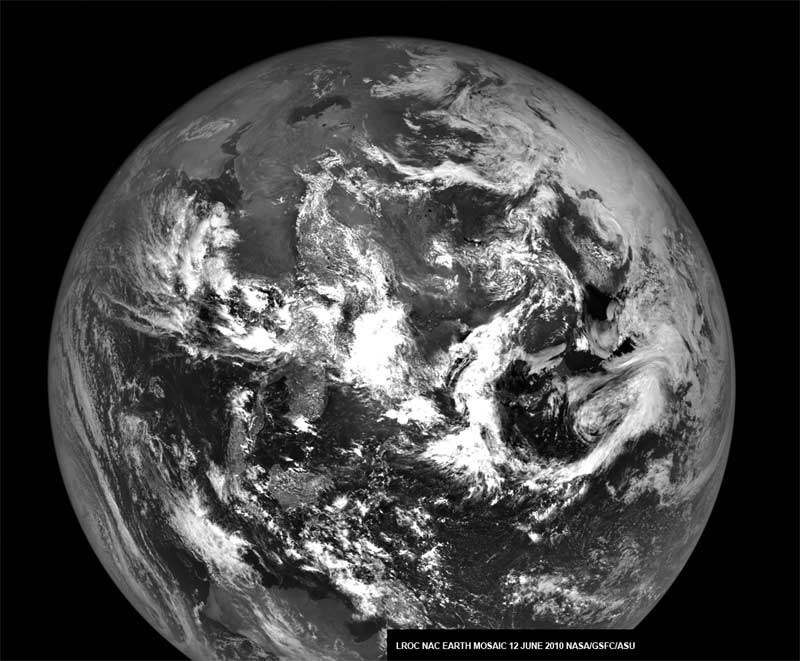New Photo of Earth Taken From the Moon

An eye-catching new view of Earth has been caught oncamera by an American spacecraft circling the moon.
The new photo of Earth was taken from a distance of 231,358miles (372,335 km) by NASA's unmanned Lunar Reconnaissance Orbiter during aroutine camera test as the probe orbited around the moon. The black-and-whitesnapshot catches Earth's portrait as it appeared on June 12.
"It wasa beautiful clear summer day over the North Pole, you can see ice covering mostof the Arctic Ocean with a few leads of open water (dark) starting to openup," wrote Mark Robinson, ?principal investigator for the powerful LunarReconnaissance Orbiter Camera (LROC) at Arizona State University, after postingthe photo Thursday.
The photowas taken by the orbiter's narrow angle camera and has a resolution of about nearly2.3 miles (3.7 km) per pixel. At the center of the image is Hong Kong, with muchof the Middle East clearly visible. [Details of the new Earth photo.]
The image isactually a mosaic of photos taken by the lunar camera as it panned across theplanet. One swirling rock formation can be seen running through parts of Iran,Afghanistan and Pakistan, Robinson wrote.
NASAlaunched the LunarReconnaissance Orbiter in June 2009 to seek out potential landing sites onthe lunar surface for future missions, as well as hunt for signs of water ice. Sofar, the orbiter has found NASA's past Apollo moon landing sites and evidenceof wateron the moon (the latter with the help if its partner probe LCROSS ? whichcrashed into the moon last year while the orbiter watched ? and other probes).
But everynow and then, mission scientists have to point the orbiter's LROC camera systemat the Earth for calibration sessions.
Get the Space.com Newsletter
Breaking space news, the latest updates on rocket launches, skywatching events and more!
The moon's subtlecolor changes make it a poor target to measure scattered light, Robinsonexplained. The Earth is a bright target against the ultra dark background ofblack space, so any image anomalies caused by scattered light (light reflectingoff internal parts of the camera) are easily measured, he added.
"Fromthe moon, the Earth serves that function well," Robinson wrote.
Thesecalibration sessions allow scientists to fine-tune the Lunar ReconnaissanceOrbiter's seven-color wide angle camera in order to account for scattered lighteffects in its photos. While the wide angle camera is being calibrated, theorbiter's narrow angle camera is free to snap photos of Earthfrom space.
"Imagine standing on the moon looking back at theEarth!" Robinson wrote. "When humans start to live and work on thenearside of the moon, they will have a constant, spectacular view of our homeplanet."
Until then, he added, the people of Earth will have tosettle for photos from robots.
- Top 10Views of Earth From Space
- Images -Earth Seen From Space Station's Windows
- PaleBlue Crescent: Earth Seen from Deep Space
Join our Space Forums to keep talking space on the latest missions, night sky and more! And if you have a news tip, correction or comment, let us know at: community@space.com.

Space.com is the premier source of space exploration, innovation and astronomy news, chronicling (and celebrating) humanity's ongoing expansion across the final frontier. Originally founded in 1999, Space.com is, and always has been, the passion of writers and editors who are space fans and also trained journalists. Our current news team consists of Editor-in-Chief Tariq Malik; Editor Hanneke Weitering, Senior Space Writer Mike Wall; Senior Writer Meghan Bartels; Senior Writer Chelsea Gohd, Senior Writer Tereza Pultarova and Staff Writer Alexander Cox, focusing on e-commerce. Senior Producer Steve Spaleta oversees our space videos, with Diana Whitcroft as our Social Media Editor.









